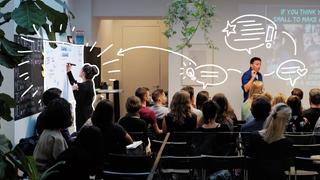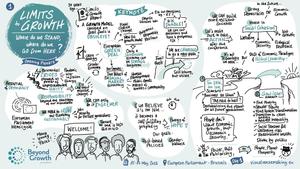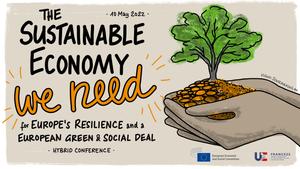In this page
What is Graphic Recording?
(Also known as Visual Recording, Visual Notetaking, Live Scribing or Visual Harvesting.)
Graphic Recording turns spoken words and ideas into visuals. As a Graphic Recorder, I listen deeply, synthesize, and draw real-time visual summaries.
You can integrate this form of Visual Notetaking in meetings, workshops, conferences, and events. The visual summaries help capture the key points of the discussion. They can make it easier for participants to understand, remember, and engage with the content.
Simply put, a Graphic Recording makes visible what people say.
What about Graphic Facilitation or Sketchnoting?
Graphic Facilitation is a related but distinct service. As a Graphic Facilitator, I take an active role in the facilitation of an event. That means I focus not only on capturing information, but I also help to shape the conversation. (Contact me for more information about my Graphic Facilitation services.)
Further reading: Learn more about the difference between Graphic Recording and Graphic Facilitation on Wikipedia.
Finally, there is Sketchnoting. In my practice, Sketchnoting refers to my personal visual notes. These are usually small-scale, like in a sketchbook, and focused on my own interests.
Graphic Recording Examples
Explore some of my projects to learn more about the use cases.
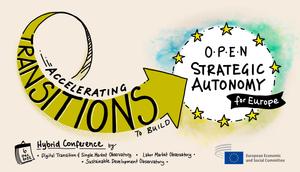
Digital Graphic Recording
Accelerating Transitions to build Open Strategic Autonomy in Europe
EESC, Brussels & Online
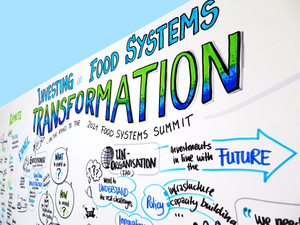
Graphic Recording
Investing in Food System Transformation - High-level Panel Discussion
House of Switzerland at World Economic Forum 2020, Davos
What I Offer
As a Graphic Recorder, I visually capture key messages, whether in-person or online. Here’s how I can support your event:
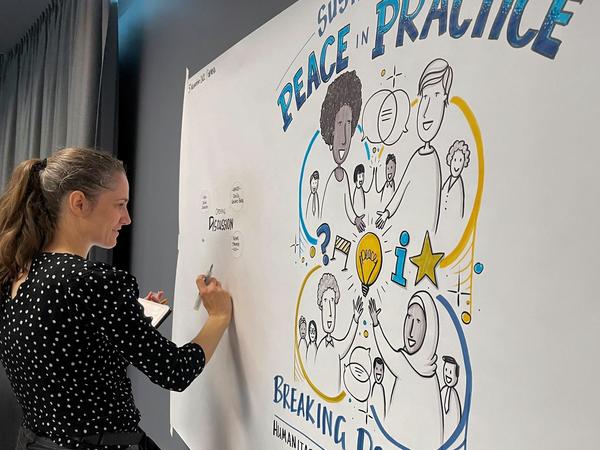
Graphic Recording on Paper
I work live on large-scale paper, either on walls, free-standing pinboards, whiteboards, or a dedicated graphic wall. The classic marker-on-paper approach highlights the creative process of visual note taking. The visual is physically present in the space. This allows participants to see the ideas and key messages unfold over the course of the event.
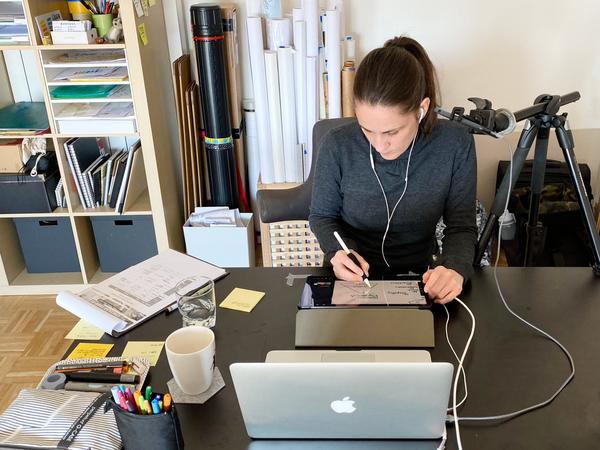
Digital Graphic Recording on the iPad
Suitable for remote, onsite, or hybrid events. Here I draw digitally on my iPad and share my screen, allowing participants to follow along as I draw. For onsite events, I connect the iPad to a projector or screen via HDMI. In virtual settings, we can easily share the drawing process through video conferences or live-streaming.
In English and German
I offer Visual Recording in both English and German. I also speak and understand casual French, and enjoy international, multi-lingual settings. Whether your event is in English, German, or a mix of languages, I can adapt to your needs.
Are you interested in exploring together how to best support your event with Visual Recording?
Benefits of Visual Notetaking for your Events
Visual Recording turns conversations into a tangible, shareable outcome. It captures key messages in real-time and creates visual summaries that help participants, facilitators, and event organizers:
Get Clear on Key Messages
Information overload is real these days. With packed presentations, tight schedules, and back-to-back sessions, it’s easy to feel overwhelmed during events.
The truth is, our brains can’t process or retain too much information at once. While Visual Recording won’t reduce the amount of information, it can bring clarity. It distills the key messages and summarizes them visually for participants, making the content easier to grasp.
Participants can easily come back to this overview of important points in their own time. Be it during a break or afterwards when they’re ready to absorb the details.
You can use the visual summary to recap the highlights of the day as part of your agenda. I’m happy to assist with that by presenting the visual and key points the the audience. This helps to anchor the information. Presenting the visual also makes it more memorable and meaningful for participants.
Remember More
We’ve all been there: you leave a meeting full of great ideas or an inspiring keynote. In the moment, you’re certain those key points will stick with you. But a week later, or even a month, how much do you actually recall?
That’s where Graphic Recording can help.
How?
-
Graphic Recording creates a visual map of the most important points. Once captured, these insights are not only documented but also presented in an engaging, easy-to-digest format. So now when you are back to business-as-usual after attending a great keynote you can simply revisit the visual to refresh your memory.
-
When you understand something better, you’re more likely to remember it. Visual notes give you a clear overview of the topics, show connections, and add a new perspective through visuals. This richer picture makes information easier to remember, especially for those who learn visually.
But it’s not just for those who like visuals. Combining spoken content and visuals helps everyone form a richer memory. And the richer the memory, the easier it is for people to recall it later.
- Visual notes are perfect for recapping information. We can use the visual to revisit the key points in a brief session during the event. Or the participants explore the image at their own pace during a break. Often they will take a picture, to be able to come back to it later. A quick glance at the image, even weeks later, can bring the main ideas back to mind. And we all know, repetition strengthens memory.
What Event Types Most Benefit from Visualization?
Visual Recording is a powerful tool that can support a variety of event types and methodologies. Here are some common categories of events that benefit from visualization:
- Workshops
- Team Retreats & Offsites
- Training & Learning Events
- Conferences & Summits
Is it the Right Tool for Your Objective?
The first step in determining if Graphic Recording is the right fit is to clarify your event’s goals. What are you hoping to achieve? What experience do you want to create for the participants?
Defining the core purpose of your event will help us identify how visualization can best support your objectives. Here are some possibilities:
- Learning & Knowledge Sharing
- Sharing Information
- Co-Creation
- Seeing the Big Picture
- Getting on the Same Page / Alignment
- Making People Feel Heard
- …
When you know your purpose, we can think together about how to integrate visualization to best support it. To get more concrete, it helps to ask yourself:
What outcomes do you hope to create?
Event Formats & Methods
This brings us to the question of process. What event formats do you plan to use for achieving the desired outcomes?
Let’s talk about how we can best integrate visualization to support your process. It’s helpful to have this conversation early in the planning process. This allows flexibility to tailor the agenda, align with facilitators, and work out the logistics.
Some formats that typically lend themselves to visual capture include:
- Facilitated Discussion
- Panel Discussion
- Keynote Presentations
- Ideation & Innovation Workshops (e.g., Design Thinking, Design Sprints, …)
- Vision, Mission, Values Workshops
- Strategic Planning
- Change Process
- Futures Thinking
- Art of Hosting
- World Café
- Stakeholder Engagement Workshop
- …
No matter if you’ve already chosen a format or are still in the planning phase, let’s have a conversation!
Graphic Recording is only one of many options to bring visuals into your event. I’d be happy to brainstorm with you on how visualization can add the most value for your participants and organization.
How to Book My Services
-
To bring Graphic Recording to your next event, start by contacting me to discuss your event details and specific needs. I will provide a customized proposal outlining the scope of work and pricing.
-
After you confirm your booking, we finalize the logistics. Once the event is getting closer, we will have a briefing call for alignment. The purpose is to discuss any information needed for the preparation.
-
On the event day, I will arrive with ample time to set up and get ready. Being well prepared and rested allows me to best capture and illustrate your event’s most important messages. After the event, you will receive high-quality digital images and the paper originals (if working on paper).
Let's talk
Are you interested in Graphic Recording in Geneva, Lausanne, Munich, and beyond? I am happy to discuss opportunities for your event or project.
